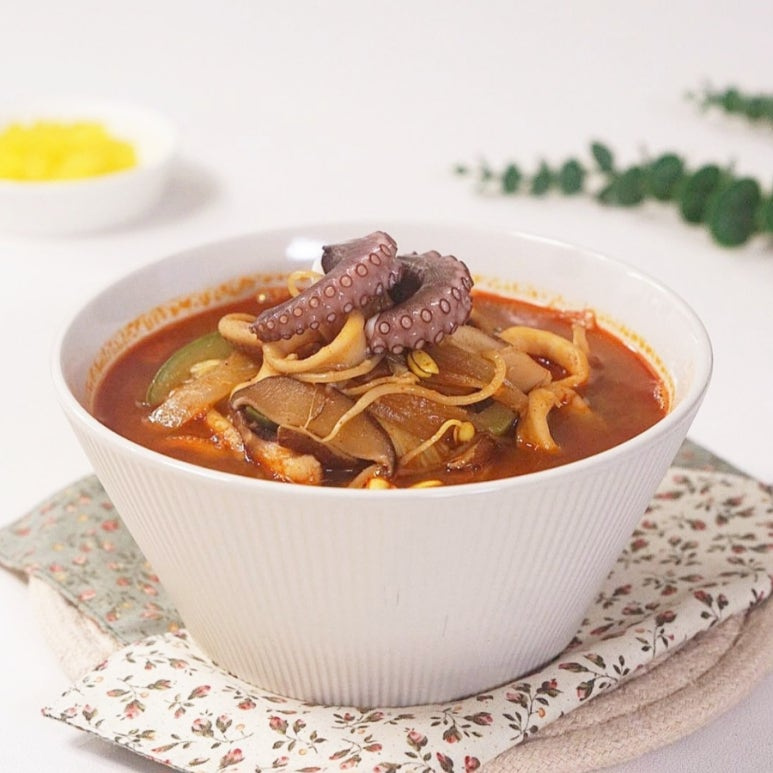Spicy Seafood Jjamppong
Rich and Flavorful Seafood Jjamppong Recipe Made at Home

Experience the deep, spicy flavor of jjamppong right in your own kitchen! While it might seem daunting, making authentic jjamppong at home is surprisingly simple. This recipe guides you through creating a hearty, rich broth packed with your favorite seafood and crisp vegetables. Follow along step-by-step for a delightful meal!
Main Ingredients- 3 Squid (or Cuttlefish)
- 1 Octopus (small)
- 550g Fresh Thick Noodles (like Kalguksu)
- 100g Napa Cabbage (outer leaves)
- 120g Bean Sprouts
- 1 Green Onion
- 2 handfuls Dried Shiitake Mushrooms (approx. 20g)
- 1 Onion (medium)
- 80g Zucchini (frozen or fresh)
- Generous amount of Cooking Oil (about 4-5 Tbsp)
- 1.5L Water
- 2 Tbsp All-purpose Flour (for cleaning seafood)
Seasoning & Broth Ingredients- 5 Tbsp Gochugaru (Korean chili flakes)
- 4 Tbsp Soy Sauce
- 3 Tbsp Oyster Sauce
- 3 Tbsp Chicken Stock (or kelp broth)
- 1 Tbsp Minced Garlic
- Plenty of Black Pepper
- Pinch of Coarse Salt (for seasoning)
- 5 Tbsp Gochugaru (Korean chili flakes)
- 4 Tbsp Soy Sauce
- 3 Tbsp Oyster Sauce
- 3 Tbsp Chicken Stock (or kelp broth)
- 1 Tbsp Minced Garlic
- Plenty of Black Pepper
- Pinch of Coarse Salt (for seasoning)
Cooking Instructions
Step 1
First, prepare the seafood. Rinse 3 squids (or cuttlefish) and 1 octopus under running water. Place them in a bowl with 2 tablespoons of flour and rub them vigorously but gently. This process removes any slimy residue, ensuring a clean taste. Rinse the seafood thoroughly and pat dry.

Step 2
Cut the cleaned octopus and squid into bite-sized pieces. Aim for roughly 2-3 cm pieces for a satisfying chew.

Step 3
Soak the dried shiitake mushrooms in lukewarm water for at least 30 minutes until rehydrated. Squeeze out the excess water and slice them. Coarsely chop the napa cabbage. Slice the green onion diagonally, focusing on the white parts. Slice the onion and zucchini into half-moons. Rinse the bean sprouts. (Tip: Add bean sprouts towards the end to maintain their crispness. Feel free to substitute or add other vegetables based on what you have available.)

Step 4
Heat a generous amount of cooking oil in a deep pot or wok over high heat. Add the sliced green onions and onions, and stir-fry for 1-2 minutes until fragrant and slightly charred. This step extracts their sweetness and aroma.

Step 5
Reduce the heat to low. Add 5 tablespoons of gochugaru and stir-fry continuously, being careful not to burn it, to create chili oil. If the mixture becomes too thick, add a little more cooking oil. Continue stir-frying for 2-3 minutes until a fragrant chili oil forms.

Step 6
Once the chili oil is ready, add 4 tablespoons of soy sauce and 3 tablespoons of oyster sauce. Continue to stir-fry for about 1 minute until the sauces are well combined and fragrant.

Step 7
Add the cut seafood to the pot. Stir-fry over medium-high heat until the seafood is cooked through. Avoid overcooking, as it can make the seafood tough. It should take about 2-3 minutes until the color changes and they plump up.

Step 8
Pour in 1.5 liters of water and bring to a boil over high heat. Skim off any foam or impurities that rise to the surface for a cleaner broth.

Step 9
Once the broth is boiling, add 3 tablespoons of chicken stock (or kelp broth for extra depth) and 1 tablespoon of minced garlic. Stir well to incorporate.

Step 10
When the broth returns to a boil, add all the remaining vegetables (napa cabbage, onion, rehydrated shiitake mushrooms, zucchini) and the bean sprouts. Boil over high heat for only 3-4 minutes, just until the vegetables are slightly tender and the bean sprouts are crisp-tender. Overcooking will make the vegetables mushy.

Step 11
Season generously with black pepper. Taste the broth and adjust the seasoning with coarse salt if needed. (Tip: Seafood releases natural saltiness, so add salt gradually.)

Step 12
In a separate pot, boil the fresh kalguksu noodles in plenty of water for about 5 minutes. Stir occasionally to prevent them from sticking together.

Step 13
Drain the cooked noodles and rinse them thoroughly under cold running water to remove excess starch. Drain well. This will make the noodles springy and chewy.

Step 14
Place the prepared noodles in a serving bowl. Ladle the hot, rich seafood jjamppong broth and generous amounts of toppings over the noodles. Your delicious homemade Seafood Jjamppong is ready to be enjoyed! 🙂



